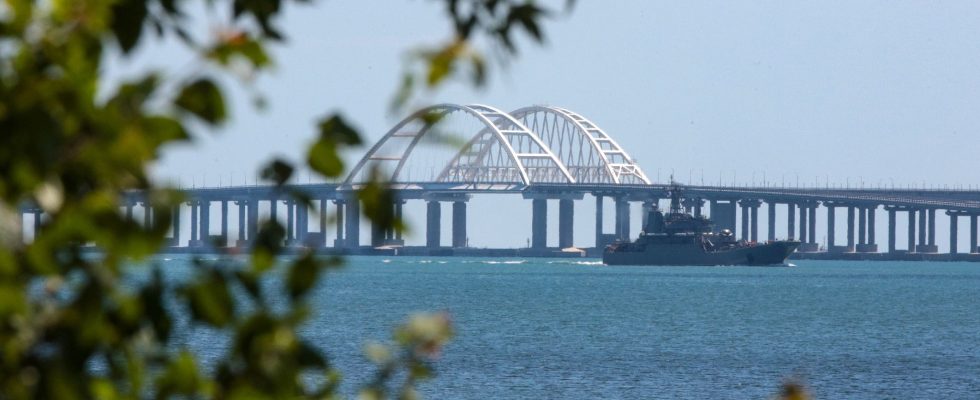They are motor boats, with no one on board, remotely controlled and which explode on contact with their targets. They can also look like canoes, zodiacs or jet skis and measure on average four to six meters. Naval drones, also called USV (Unmanned Surface Vehicle), are one of the weapons used by Ukraine. Since September 2022, kyiv has used these craft dozens of times against Russian ships in the Black Sea.
Attacks by these boats, which sail exclusively on the surface, have been increasing for several days. A Russian tanker, the GIS, was hit overnight from Friday to Saturday by a Ukrainian naval drone in the Kerch Strait, briefly interrupting traffic on the strategic bridge linking Crimea to Russia.
“During the night, the SBU (Editor’s note: Ukrainian security services) blew up the GISa major tanker from the Russian Federation which carried fuel for Russian soldiers,” a source from the Ukrainian security services told AFP on Saturday, August 5. This new “special operation” was carried out “successfully”. in Ukrainian territorial waters with a naval drone and explosives, the source added.
The day before, a Ukrainian drone strike this time targeted a Russian warship, Olenegrorsky Gornyak, at a Black Sea base in Novorossiysk. The operation was “successful”, a source within the SBU told AFP on Friday.
Russia has assured that it repelled a Ukrainian attempt involving “two unmanned boats” against this base. The naval drones “were visually detected and destroyed by fire” from Russian ships, according to the Defense Ministry. The ministry announced in a separate statement that it shot down 13 unmanned aircraft over Crimea, with no casualties or damage.
“Elementary and practical” boats
“Surface drones are simple to set up technically and they are not expensive. They are elementary and very practical”, summarizes with L’Express Pascal Ausseur, former admiral and director general of the Mediterranean Foundation of strategic studies (FMES). “But for it to remain very simple and inexpensive, it must have simple means of communication: HF or VHF radio waves.”
“It’s very low-tech, which consists of designing and building a boat with a polymer, putting in a steering system, a GPS and a camera – it can be bought on the market. It does not require great expertise and Ukrainian engineers are very good”, also explains at France 24 Michel Yakovleff, former Chief of Staff at NATO’s Supreme Headquarters Allied Powers Europe (SHAPE).
These boats have another advantage: they are difficult to detect by radar. “It’s a poison” for the Russian navy, underlines Pascal Ausseur, because “these naval drones are easy to send when the boat is at the dock, or when it is waiting in front of a port”. However, their speed is limited. “The weak point of a surface drone is that it cannot go very fast: around 15 to 20 knots (27 to 37 km/h) or the speed of a zodiac”, adds- he.
An explosive charge insufficient to sink a ship
The explosive charge deposited on these boats is variable: from a few tens of kilos to several hundred. “On a boat of 5 or 6 meters, there is plenty to put a lot of explosives”, notes Pascal Ausseur. “A charge of 150 kilos causes damage. For example, the Exocet, an anti-ship missile, has a similar explosive charge”, recalls this expert.
However, these charges are not enough to sink a ship. The SIG suffered a waterline hole in the engine room area, but remains afloat. “To sink a boat, it would be better to use an underwater drone, but then we would get into more complex and more expensive things,” says Pascal Ausseur.
The naval drones were probably used by kyiv in order to damage the Crimean Bridge, a highly strategic building in Russian hands. On the night of Sunday July 16 to Monday July 17, the Crimean Bridge, 18 kilometers long, was hit by at least two explosions. The attack was carried out by Ukrainian special services and naval forces using “naval drones”, an SBU source told AFP. Russian Foreign Ministry spokeswoman Maria Zakharova confirmed on Telegram that the attack was carried out by Ukraine.
A new generation of naval drones
Beyond the damage inflicted by these attacks, “the Ukrainians are sending the Russians the message that they are nowhere safe”, deciphers Pascal Ausseur. In the Black Sea, kyiv aims to “prevent” Russian boats from approaching the Ukrainian coast, he recalls. This naval battle, which “creates insecurity”, allows the Ukrainians to “show their capacity for nuisance”. But the Russians are not left out. “Each has the means to hinder or make very complicated the military use of the Black Sea by the other”, analyzes the former admiral.
“The objective (Editor’s note: by attacking the GIS) was to show that Ukraine could attack any Russian warship in this area,” a source in the Ukrainian security services told AFP.
“It is likely that Ukraine, by creating a powerful fleet of kamikaze drones, can truly lock up the ships of the Russian Black Sea fleet in the harbors where they are”, deciphers for his part Vladislav Selezniov with the agency independent press Union. As reported The International Courier, this specialist in military matters believes that “the creation of a fleet of Magura V5 naval drones will influence the course of the war”.
On the occasion of the International Defense Industry Fair (IDEF), which took place from July 25 to 28 in Turkey, the Ukrainian company SpetsTechnoExport (STE) unveiled images of this new naval drone capable of reaching a speed of 75 km/h on water. Equipped with an explosive charge of 320 kg, it has a range of 800 km. The naval battle is not over.
